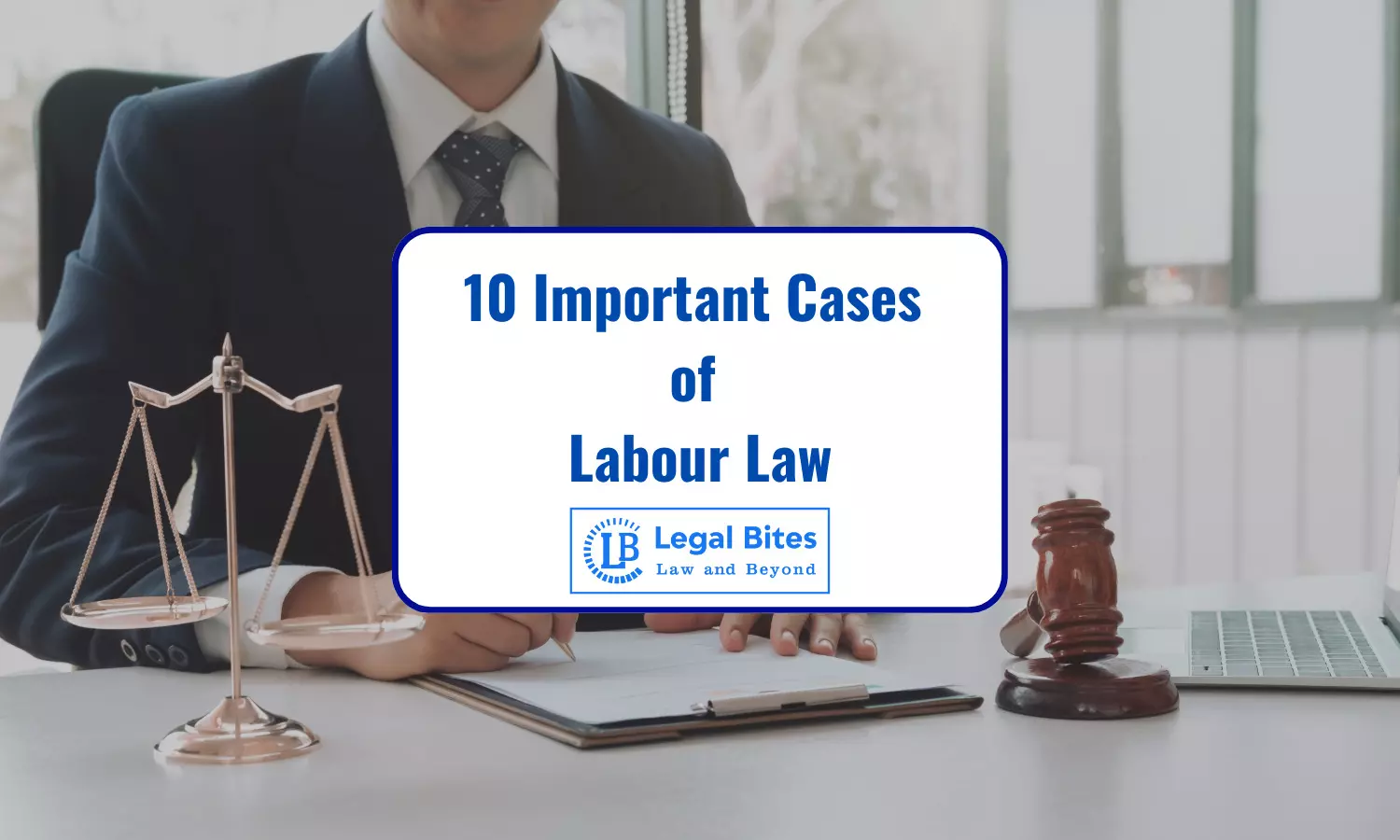10 Important Cases of Labour Law
This article presents a comprehensive overview of ten landmark cases that have significantly influenced the evolution of labour laws in India.

The article '10 Important Cases of Labour Law' presents a comprehensive overview of ten landmark cases that have significantly influenced the evolution of labour laws in India.
Labour law covers employment contracts, wages, health and safety, fair treatment of employees, dispute resolution mechanisms and so on and so forth. It provides regulations that govern the relationship between an employee and the employer in a workplace. Labour laws play an important role in the protection of the rights of employees. The cases discussed below aim to cover various aspects of labour laws.
1. Workmen of M/S Firestone Tyre and Rubber Co. of India v. Management[1]
In the instant case, the workers of the Firestone Tyre & Rubber Company were terminated from their employment by the employer as a result of the Domestic Inquiry Finding. Meanwhile, during the pendency of the suit, the amendment to the Industrial Tribunal Act in 1971, brought in Section 11 A which conferred Industrial Tribunal with the Appellate Authority power over domestic inquiries into emerging disputes. The Tribunal gave a decision in favour of the employer and therefore dissatisfied with the decision; the aggrieved workers appealed to the Apex court against the order passed by the tribunal. The Supreme Court considered on the understanding of Section 11A of the Industrial Disputes Act, 1947 and acknowledged the Industrial Disputes Act, 1947 as a beneficial legislative measure drafted for the welfare of employees.
However, the court ruled that since the lawsuit was started before the amendment, the said section would not be applicable in this case. It would only be relevant to cases started after the amendment to the Industrial Dispute Act, 1947.
2. Bandhua Mukti Morcha v. Union of India[2]
A PIL was filed by an organization named Bandhua Mukti Morcha who were actively fighting against the abhorrent practice of bonded labour. The organisation outlined a survey report, conducted in stone quarries in the Faridabad district which revealed numerous workers facing inhuman & intolerable conditions, with a drive of forced labour.
In response to the highlighted facts, the Court recognized guidelines for identifying bonded labourers and directed that state governments must locate, release, and rehabilitate the bonded labourers. The court also declared that a person being a bonded labourer is deprived of liberty, and is a slave with no freedom in choosing employment.
The court also ruled that if it is established that a worker is engaged in forced labour, the presumption is that economic deliberations are involved, and therefore, the worker is a bonded labourer. This presumption can only be refuted by the employer & the state government if they deliver satisfactory evidence.
3. Steel Authority of India Limited v. National Union Waterfront Workers[3]
The Government of West Bengal originally forbade contract labour at specified stockyards in Calcutta by virtue of the Contract Labour (Regulation and Abolition) Act, 1989. The prohibition was temporarily put off through a notification dated August 28, 1989, but it was extended until August 31, 1994. The contracted labourers of a central government enterprise which were primarily involved in manufacturing iron and steel products and engaged in import-export had its branches across India, petitioned the Calcutta High Court to direct the appellants, SAIL, to fascinate them into their consistent establishment due to the West Bengal government's prohibition. The Calcutta High Court, considering the State Government as the appropriate authority dismissed the writ petition. In response to this, the appellants appealed to the Supreme Court, putting in question, the interpretation of "appropriate government" enshrined in Section 2(1)(a) of the Contract Labour (Regulation and Abolition) Act, 1970.
The apex court lined that any company working under the authority of the Central Government undertakings, which fails to function due to a lack of conferred power, is considered an industry under the Central Government. Subsequently, the court determined that as per the Contract Labour (Regulation and Abolition) Act, 1970, the appropriate government was the Central Government.
4. People’s Union for Democratic Rights v. Union of India[4]
The PUDR is an organization formed to protect the democratic rights of the Citizens. In the instant case, PUDR appointed three scientists for the inquiry to be conducted in the ASIAD Projects. Based on the investigation report the petitioner addressed a letter to Justice P.N Bhagwati which served as a Public Interest Litigation. The letter highlighted violations of various labour laws and the apex court was requested to look into the issue. The letter was considered as a writ petition by the Supreme Court. Notices were issued to the Union Government, the Delhi Development Authority & the Delhi Administration.
The major allegations highlighted-
The violation of the Equal Remuneration Act, 1976( women workers were not paid properly; misappropriation of money).
The violation of Article 24 of the Constitution of India, the Employment of Children Act, 1938 & 1970 as the children below 14 years were engaged at the construction site by the contractors.
The violations of the Contract Labour (Regulation and Violation) Act of 1970, resulted in the maltreatment of the workers and denial of their various rights.
The apex court in this case found that the stated violations did happen and at a gross means. The court held that there were abuse of labour laws in mass and the State was obliged to take action against such violation ensuring that the fundamental rights of the labourers are safeguarded.
5. Syndicate Bank and Ors v. K. Umesh Nayak[5]
The major issue in the instant case before the Apex Court was whether the workmen were entitled to get paid during the period of strike despite the strike’s nature, legal or illegal.
The Apex Court held that unless a strike contradicts the provisions of the Industrial Disputes Act, 1947, it would be considered legal. Close scrutiny is essential to be applied to the particular factual condition of each claim.
In the instant case, the strike was a result of longstanding disputes between employees and employers. It is the last resort available to the employees for their demands to be fulfilled by the industry. The Industrial Legislation provides for worker’s right to protest and the right of the employer to lockout & provide machinery for peaceful inquiry & clearance of disputes between them. Therefore, the Court ordered that the employees be paid for the strike period.
6. Municipal Corporation of Greater Bombay v. Labour Appellate Tribunal of India[6]
Retrenchment was questioned in this case. The term retrenchment amounts to the termination done by the employer of the employee for reasons other than giving punishment through disciplinary action. It is generally done to relieve them from a job in good faith. In this particular case, the employer sent a show cause notice to the employee after leading an inquiry into misconduct. As a result, the employee was terminated being found guilty and unfit for continued employment with the company. The terminated employee filed a petition seeking restoration and compensation on grounds of termination. The Labour Court ruled in favour of the employee. This decision was challenged by the appellant in Bombay High Court. The High Court decided that this case did not involve retrenchment because the employee’s termination was based on misconduct.
7. M.C. Mehta v. State of Tamil Nadu[7]
In the instant case, Shri MC Mehta invoked Article 32, for violation of fundamental rights of children guaranteed under Article 24. The Court found Sivakasi was the main offender who was employing many child labourers, engaging them in the manufacturing process of matches and fireworks which is qualified as a hazardous industry and held employing children under the age of 14 years in this industry is prohibited.
The Court restated that children below the age of fourteen must not be engaged in any hazardous industry and must ensure all children get free education till the age of 14 years. The Court further also looked at Article 39 (e) which states that the children’s tender age should not be exploited but instead, the opportunities for their healthy growth and development. Therefore, the Court directed the employer Sivakasi must pay a compensation of Rs. 20,000 for violation of the Child Labour (Prohibition and Regulation) Act, 1986.
8. Hindustan Aeronautics Limited v. Workmen[8]
The appellant Hindustan Aeronautics Limited is a company registered under Section 617 of the Companies Act, 1956, belonging to the Central Government. The case is about 1000 workers, working in the company’s repairing unit at Barrackpore, West Bengal were facing issues w.r.t the allowance of the employee’s education, revision of lunch allowances and job permanency. The dispute was then taken by the West Bengal Government under Section 10 (1) to the Industrial Tribunal. The Industrial Tribunal partly awarded some relief to the workers. As a result, the Appellants took their case to the Apex Court and questioned whether the West Bengal government was an appropriate government or not, to resolve the dispute.
The Supreme Court held that the West Bengal government is the appropriate government keeping in mind the company’s subsidiary in West Bengal carried on different business.
Therefore, when there arises a situation of conflict or breakdown, the government of West Bengal has the authority to settle any dispute and keep industrial peace.
9. Bata Shoe Co. Ltd. v. D.N Ganguly[9]
The case is related to a dispute that emerged between Bata Company and the workers. The parties opted for the process of Conciliation to reach a settlement. But the workers initiated a strike post-settlement for which the company declared the strike illegal, stating its contradiction to the earlier settlement. Accordingly, the company conducted an inquiry and terminated the striking workers. In executing the termination dispute, another conciliation proceeding arose, resulting in a signed agreement between both parties. Remarkably, no conciliation officer was present throughout this process.
The main issue before the apex court was whether a settlement executed between the company and the workers could exist in accordance with Section 12 and Section 18 of the Industrial Disputes Act, 1947. The apex court held that the first settlement was binding since it was in accordance with the specified sections however the subsequent settlement remains non-binding since it was contrary to the specified provisions of the Industrial legislation.
10. Bangalore Water Supply v. A. Rajappa & Others[10]
A. Rajappa was an employee of the Bangalore Water Supply and Sewerage Board. A labour dispute was persisting between the employee and the board. A. Rajappa along with several other workmen were fined by the Board for misconduct. A hefty amount was recovered from them which was not reasonable. Therefore A. Rajappa along with other workmen approached the Labour Court. The issue was whether Bangalore Water Supply and Sewerage Board fell within the definition of industry under Section 2(j) of the Industrial Dispute Act, 1947. The Supreme Court of India dismissed the Bangalore Water Supply and Sewerage Board's appeal and held it within the industry definition under the Industrial Dispute Act, 1947.
References
[1] 1973 SCR (3) 587
[2] AIR 1984 SC 802
[3] Appeal (Civil) 6009-6010 of 2001
[4] 1982 AIR 1473
[5] 1994 SCC (5) 572
[6] AIR 1957 Bom 188
[7] AIR 1997 SC 699
[8] 1975 AIR 1737
[9] 1961 AIR 1158
[10] AIR 1978 SC 548
Important Links

